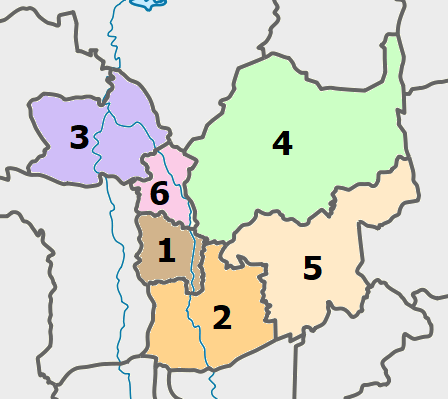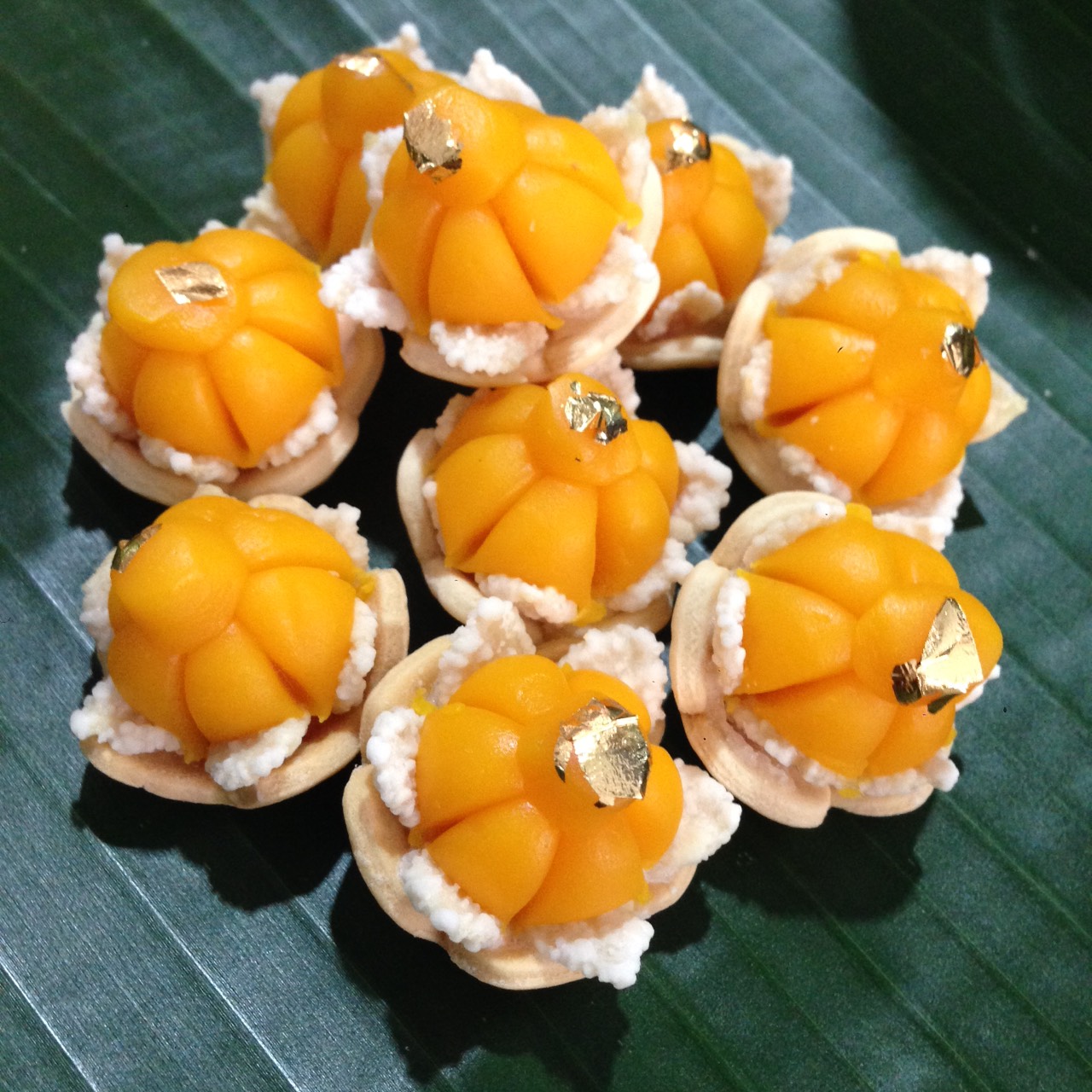|
Khanom Khai Pla
Khanom khai pla ( th, ขนมไข่ปลา, ; literally: "fish-roe snack") is a type of Thai dessert. It can be considered as a rare and little known dessert. ''Khanom khai pla'' is made from the ripe toddy palm fruit (similar to ''khanom tan''), rice flour and white sugar, it is then formed into what resembles fish roe and then boiled in water or clean syrup. Once cooked it floats to the surface, where it is removed and sprinkled with shredded coconut. It also has a taro flavour. Presently, as far as is known, it is only cooked and sold in two places viz Ko Kret in Nonthaburi and 100 Years Sam Chuk Old Market in Sam Chuk, Suphan Buri. See also * List of Thai desserts and snacks This is a list of Thai khanom, comprising snacks and desserts that are a part of Thai cuisine. Some of these dishes are also a part of other cuisines. The word "khanom" ( th, ขนม), refers to snack or dessert, presumably being a compound betw ... References Thai desserts and snacks< ... [...More Info...] [...Related Items...] OR: [Wikipedia] [Google] [Baidu] |
Thailand
Thailand ( ), historically known as Siam () and officially the Kingdom of Thailand, is a country in Southeast Asia, located at the centre of the Indochinese Peninsula, spanning , with a population of almost 70 million. The country is bordered to the north by Myanmar and Laos, to the east by Laos and Cambodia, to the south by the Gulf of Thailand and Malaysia, and to the west by the Andaman Sea and the extremity of Myanmar. Thailand also shares maritime borders with Vietnam to the southeast, and Indonesia and India to the southwest. Bangkok is the nation's capital and largest city. Tai peoples migrated from southwestern China to mainland Southeast Asia from the 11th century. Indianised kingdoms such as the Mon, Khmer Empire and Malay states ruled the region, competing with Thai states such as the Kingdoms of Ngoenyang, Sukhothai, Lan Na and Ayutthaya, which also rivalled each other. European contact began in 1511 with a Portuguese diplomatic mission to Ayutthaya, w ... [...More Info...] [...Related Items...] OR: [Wikipedia] [Google] [Baidu] |
Central Thailand
Central Thailand (Central plain) or more specifically Siam (also known as Suvarnabhumi and Dvaravati) is one of the regions of Thailand, covering the broad alluvial plain of the Chao Phraya River. It is separated from northeast Thailand (Isan) by the Phetchabun mountain range. The Tenasserim Hills separate it from Myanmar to the west. In the north it is bounded by the Phi Pan Nam Range, one of the hilly systems of northern Thailand. The area was the heartland of the Ayutthaya Kingdom (at times referred to as Siam), and is still the dominant area of Thailand, containing as it does, the world's most primate city, Bangkok. Definition The grouping of Thai provinces into regions follow two major systems, in which Thailand is divided into either four or six regions. In the six-region system, commonly used in geographical studies, central Thailand extends from Sukhothai and Phitsanulok Provinces in the north to the provinces bordering the Gulf of Thailand in the south, excluding the m ... [...More Info...] [...Related Items...] OR: [Wikipedia] [Google] [Baidu] |
Thai People
Thai people ( th, ชาวไทย; ''endonym''), Central Thai people ( th, คนภาคกลาง, sou, คนใต้, ตามโพร; ''exonym and also domestically'') or Siamese ( th, ชาวสยาม; ''historical exonym and sometimes domestically''), T(h)ai Noi people ( th, ไทยน้อย; ''historical endonym and sometimes domestically''), in a narrow sense, are a Tai ethnic group dominant in Central and Southern Thailand (Siam proper). Part of the larger Tai ethno-linguistic group native to Southeast Asia as well as Southern China and Northeast India, Thais speak the Sukhothai languages ( Central Thai and Southern Thai language), which is classified as part of the Kra–Dai family of languages. The majority of Thais are followers of Theravada Buddhism. As a result of government policy during the 1930s and 1940s resulting in successful forced assimilation of many the various ethno-linguistic groups in the country into the dominant Thai language and ... [...More Info...] [...Related Items...] OR: [Wikipedia] [Google] [Baidu] |
Thai Dessert
This is a list of Thai khanom, comprising snacks and desserts that are a part of Thai cuisine. Some of these dishes are also a part of other cuisines. The word "khanom" ( th, ขนม), refers to snack or dessert, presumably being a compound between two words, "khao" (ข้าว), "rice" and "khnom" (หนม), "sweet". The word "khanom" in the Thai sense is snack or sweet food made from flour. Thai khanom * '' Bua Loy, rice flour rolled into small balls and then cooked in coconut milk.'' * '' Bulan dan mek'' * '' Lot chong'' * '' Cha mongkut'' * ''Fakthong kaeng buat'' * '' Foi thong'' * Fresh fruit * ''Grass jelly'' * '' Khanom babin'' * '' Khanom bueang'' – known as Thai crêpes * ''Khanom chan'' – means layer dessert * ''Khanom keson lamchiak'' * ''Khanom khai pla'' * '' Khanom khrok'' * ''Khanom khuai ling'' * ''Khanom mo kaeng'' * ''Khanom namdokmai'' * ''Khanom phing'' * ''Khanom piakpun'' * ''Khanom sane chan'' * ''Khanom sot sai'' * '' Khanom ... [...More Info...] [...Related Items...] OR: [Wikipedia] [Google] [Baidu] |
Borassus Flabellifer
''Borassus flabellifer'', commonly known as doub palm, palmyra palm, tala or tal palm, toddy palm, wine palm or ice apple, is native to South Asia (especially in Bangladesh & South India) and Southeast Asia. It is reportedly naturalized in Socotra and parts of China. Description ''Borassus flabellifer'' is a robust tree and can reach a height of . The trunk is grey, robust and ringed with leaf scars; old leaves remain attached to the trunk for several years before falling cleanly. The leaves are fan-shaped and long, with robust black teeth on the petiole margins. Like all ''Borassus'' species, ''B. flabellifer'' is dioecious with male and female flowers on separate plants. The male flowers are less than long and form semi-circular clusters, which are hidden beneath scale-like bracts within the catkin-like inflorescences. In contrast, the female flowers are golfball-sized and solitary, sitting upon the surface of the inflorescence axis. After pollination, these blooms develop i ... [...More Info...] [...Related Items...] OR: [Wikipedia] [Google] [Baidu] |
Rice Flour
Rice flour (also rice powder) is a form of flour made from finely milled rice. It is distinct from rice starch, which is usually produced by steeping rice in lye. Rice flour is a common substitute for wheat flour. It is also used as a thickening agent in recipes that are refrigerated or frozen since it inhibits liquid separation. Rice flour may be made from either white rice or brown rice. To make the flour, the husk of rice or paddy is removed and raw rice is obtained, which is then ground to flour. Types and names By rice Rice flour can be made from indica, japonica, and wild rice varieties. Usually, rice flour ( zh, c=米粉, p=mǐfěn, ja, 米粉, komeko, ko, 쌀가루, ssal-garu, vi, bột gạo, th, แป้งข้าวเจ้า, paeng khao chao, lo, ແປ້ງເຂົ້າຈ້າວ, pèng khao chao, km, ម្សៅអង្ករ, msau ângkâ, my, ဆန်မှုန့်, hcan hmun, ms, tepung beras, tr, pirinç) refers to flour made f ... [...More Info...] [...Related Items...] OR: [Wikipedia] [Google] [Baidu] |
White Sugar
White sugar, also called table sugar, granulated sugar, or regular sugar, is a commonly used type of sugar, made either of beet sugar or cane sugar, which has undergone a refining process. Description The refining process completely removes the molasses to give the white sugar, sucrose. It has a purity higher than 99.7%. Its molecular formula is . White sugars produced from sugar cane and sugar beet are chemically indistinguishable: it is possible, however, to identify its origin through a carbon-13 analysis. White sugar (and some brown sugar) produced from sugar cane may be refined using bone char by a few sugar cane refiners. For this reason white sugar from sugar cane may not be vegan. Beet sugar has never been processed with bone char and is vegan. From a chemical and nutritional point of view, white sugar does not contain—in comparison to brown sugar—some minerals (such as calcium, potassium, iron and magnesium) present in small quantities in molasses. The only detec ... [...More Info...] [...Related Items...] OR: [Wikipedia] [Google] [Baidu] |
Khanom Tan
Khanom tan ( th, ขนมตาล; ) is a popular Thai dessert consisting of small steamed cakes flavoured with toddy palm sugar and coconut milk, wrapped in banana leaves, and topped with grated coconut. It is most often found in the provinces where sugar palm is grown, such as Phetchaburi, Nakhon Pathom and Suphanburi. History Khanom Tan is one of many popular Thai desserts that dates from the Sukhothai period. During that time, the main ingredients used in preparing desserts were rice flour, sugar and coconut, in contrast to desserts from the later Ayutthaya period, which are based on a mixture of eggs and sugar. Today, Khanom Tan is not well known among younger generations due to its disappearance from street markets, but it is still a popular Thai dessert outside of the Bangkok area. Preparation Khanom tan is made using a similar technique to the steamed dessert khanom kluay, the key difference being that khanom tan requires the batter to be fermented to achieve a spo ... [...More Info...] [...Related Items...] OR: [Wikipedia] [Google] [Baidu] |
Ko Kret
Ko Kret ( th, เกาะเกร็ด, ) is a small island in the Chao Phraya River in Nonthaburi province, Thailand. It is around long and wide with an area of over 4.2 square kilometers. It has seven main villages, the largest and most populous being Ban Mon. The island is best known for Thai-Mon people who make pottery for a living. The island is served by ferries. History Ko Kret was originally a meander located on Chao Phraya River. Due to Chao Praya river's curvy path, ships often take longer time to reach Ayutthaya, Siam's capital at the time. During the reign of King Thaisa, His majesty wanted to reduce shipping time and improve the kingdom's economy. Thus, he planned a canal which would bypass the meander and act as a shortcut for maritime transport. According to the Ayutthaya chronicles, the canal was dug in 1722, requiring around 10,000 men and taking over a month to complete. After the canal was dug, shipping to Ayutthaya became faster and the canal was called ... [...More Info...] [...Related Items...] OR: [Wikipedia] [Google] [Baidu] |
Sam Chuk
Sam Chuk ( th, สามชุก, ) is a district (''amphoe'') in the northern part of Suphan Buri province, central Thailand. History Originally the district name was ''Nang Buat''. In 1911 when the government separated part of Nang Buat District and established Doem Bang district, it also moved the district office to Ban Sam Pheng, Tambon Sam Chuk. In 1939 the district name was changed to Sam Chuk as the central tambon. Geography Neighbouring districts are (from the south clockwise): Si Prachan, Don Chedi, Nong Ya Sai and Doem Bang Nang Buat of Suphan Buri Province, and Sawaeng Ha of Ang Thong province. The main water resource of Sam Chuk is the Tha Chin River or Suphan river. Economy Thailand's Sam Chuk community and Old Market District along the Tha Chin River was granted an Award of Merit in the 2009 United Nations Educational, Scientific and Cultural Organization (UNESCO) Asia-Pacific Heritage Awards for Culture Heritage Conservation. Local residents formed a ... [...More Info...] [...Related Items...] OR: [Wikipedia] [Google] [Baidu] |



_fruit.jpg)

